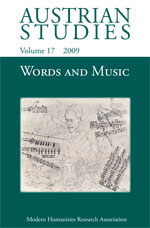MHRA Style Citation Demonstration
Click cover to enlarge | According to the MHRA Style Guide, this item should be cited in a bibliography as follows: Beniston, Judith, Geoffrey Chew, and Robert Vilain (eds). 2010. Words and Music (= Austrian Studies, 17) This is in the author-date variant of MHRA style. MHRA's journals don't allow author-date citation, but some of its book series (notably Legenda) do: please talk to your editor before using this. (To see the demonstration for regular style instead, follow this link.) Let's take this bibliography entry one step at a time: Step 1. The entry begins with the author(s) or editor(s) of the volume, with the first name inverted into Surname, Forename. This is because a Bibliography is a list in surname order, so we need a surname up front. Beniston, Judith, Geoffrey Chew, and Robert Vilain Step 2. If somebody has a role other than that of author, it goes next, in brackets. One editor becomes '(ed.)', two or more '(eds)'. (Remember: 'ed.' stands for 'editor', not 'edited', so the full stop must be used, because 'd' is not its last letter.) Beniston, Judith, Geoffrey Chew, and Robert Vilain (eds) Step 3. Now a full stop, the year of publication, and another a full stop: Beniston, Judith, Geoffrey Chew, and Robert Vilain (eds). 2010. Step 4. This is a themed and titled journal issue, so we give that title here, just as if it were a book. Beniston, Judith, Geoffrey Chew, and Robert Vilain (eds). 2010. Words and Music Step 5. We gave this a title as if it were a book, but we need to give the equivalent journal citation as well: note the '=' sign. Beniston, Judith, Geoffrey Chew, and Robert Vilain (eds). 2010. Words and Music (= Austrian Studies, 17) And that's the finished bibliography entry. Note that there's no final full stop. So how about citations in the main text, or in footnotes or endnotes? The advantage of the author-date system is that these are very concise. In fact, you don't need a note at all. Suppose we quote from page 21: The author reminds us of Shakespeare’s view: ‘Better a foolish wit than a witty fool’ (Beniston, Chew, and Vilain 2010: 21). And notes are concise too. There's no difference in how to treat the first and subsequent notes. 34 Beniston, Chew, and Vilain 2010. So is author-date easier than regular MHRA style? Not always. Firstly, it may not be allowed by your editor, so check before using. But secondly, it makes books easier to write, but only at the cost of making them harder to proof-read. If you discover at the last moment that Blenkinsop 1996 was actually published in 1995, that can mean hundreds of corrections to make, and it gets worse if an author has many publications in the same year, because Blenkinsop 1996e and Blenkinsop 1996d are easy to confuse. |
